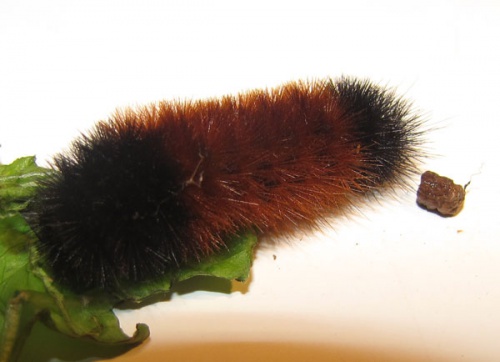Care for Woolly Bear Caterpillars
Woolly bears, the caterpillar form of the Tiger Moth, are a well-known sign of spring in North America. These charmingly fluffy caterpillars can be raised to adults at home as an educational project for children, or simply for aesthetic pleasure. You will need to provide your caterpillars with a solid habitat, feed them, and then release them into the wild once they turn into moths.
Contents
Steps
Providing the Right Habitat
- Use the right container. You can safely keep a woolly bear caterpillar in a clear plastic jar, like a mason jar. The jar should have a lid to prevent the caterpillar from escaping. You can also use a cardboard box.
- You should punch small holes on the lid. You can also use a mesh lid. It's important for the jar to have some air circulation.
- Provide twigs. Your caterpillar will need a twig to build a cocoon. Place a small twig or branch from outside in the caterpillar's jar. Angle the branch in a diagonal fashion, as this will allow the caterpillar to climb onto it when it's ready to build its cocoon.
- Clean the container regularly. Each day, you will notice the caterpillar has left droppings in the container. These should be cleaned out regularly. You can move the caterpillar out of the container and use a tissue paper to wipe up droppings.
- Keep the container outside. Woolly bear caterpillars need a cold environment to thrive. You should keep the container in a secure location outdoors. Something like a garage or shed near your house is a safe place to keep your caterpillar.
Feeding Your Caterpillar
- Provide plants from where you found your caterpillar. Caterpillars will do best feeding off their original host plants. Remove some of the leaves and plants from where you found your caterpillar. Place them in the caterpillar's container.
- For example, if you found your caterpillar on a tree in your yard, remove leaves from that tree of your caterpillar's home.
- Feed your caterpillar leaves. Caterpillars can benefit from eating leaves from outdoors. If you find leaves on the ground, bring them in from outdoors. Scatter them on the bottom of your caterpillar's container. Green and dry leaves can both work. You should feed your caterpillar leaves daily.
- Add flowers and grasses. Caterpillars also eat flowers and grass, so bring those in from outdoors as well. Things like dandelions, grass, plantains, and burdock can be great to help a caterpillar thrive. Provide fresh flowers daily.
- Mist the cage regularly. Wooly Bear Caterpillars do not need a water container and it can actually be a drowning hazard. However, misting the environment is important. Each day, use a spray bottle to mist the bottom of the container. Small droplets of water can help a Wooly Bear Caterpillar stay hydrated.
Releasing Your Caterpillar
- Place dead leaves in the container during winter. When winter comes, add dead leaves to the caterpillar's container. This will allow the caterpillar somewhere warm to sleep during the colder months. Eventually, the caterpillar will build a cocoon, but it will not do so until spring. It's important to keep your caterpillar warm over the winter.
- Move the container indoors when your caterpillar builds its cocoon. In the spring, you will notice your caterpillar will stop moving and take to its branch. Eventually, it will build a cocoon. Once the caterpillar has built a cocoon, it is safe to bring it inside. You will be able to better observe the moth inside.
- Feed the moth when it emerges. Before the moth emerges, provide extra twigs in the container. You should also add fresh flowers. As you will not be releasing the moth for a few days, it will need these food sources.
- Release the moth after two days. You can enjoy your moth for a few days after it emerges. Observe the moth in its container and watch it feed on leaves and grass. If you have young children, this can be a great learning experience. However, after a few days, you should release the moth outdoors near where you found it. A moth cannot comfortably live in a small container the same way a caterpillar can.
Warnings
- Don't touch the newly hatched moths, as their wings could be damaged. If they are damaged, they could easily die or become crippled.
Related Articles
- Raise Butterflies
- Make an Egg Carton Caterpillar
- Make a Cardboard Dollhouse
- Design a Container Garden
- Play Capture the Flag
- Observe Better Sleep Month
- Provide Healthy Air for Your Birds
- Release Endorphins
- Choose Edible Flowers
- Care for a Caterpillar
- Eat a Live Caterpillar
- Take Care of Butterflies
- Care for a Black Swallowtail Caterpillar
